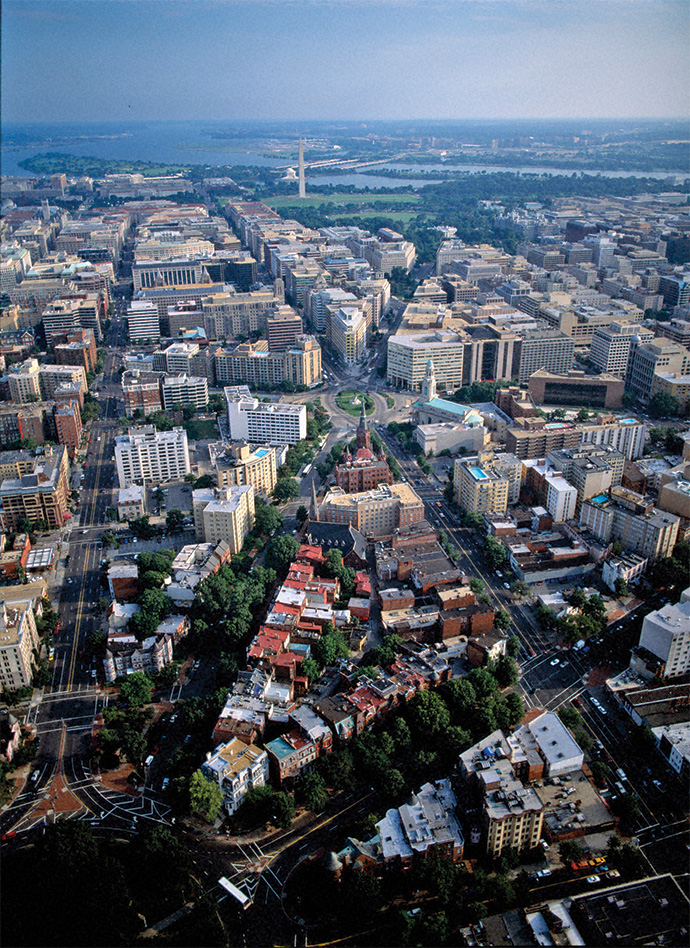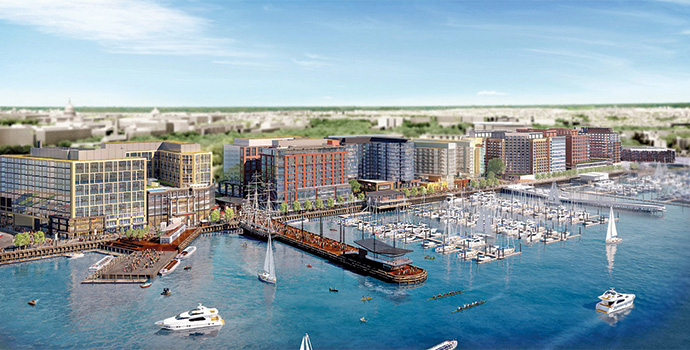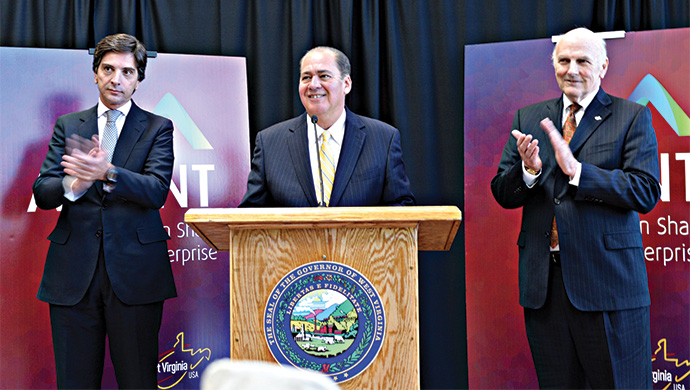In a region rich with historical and geographical diversity, it’s only fitting that economic development projects are equally diverse, ranging from District-wide redevelopment to eco-friendly paper companies, from high finance and high tech to high stakes energy development. The four states —Delaware, Maryland, Virginia, West Virginia — and the District of Columbia, which make up the mid-Atlantic region, each have their own unique story to tell.
Delaware: The growing financial sector means jobs.
Talk about multitasking. Wilmington, Del.-based pharmaceutical company Astra Zeneca spent months considering and spurning takeover bids from Pfizer, all while negotiating and selling a portion of its campus to financial giant JP Morgan Chase. Chase purchased the 58-acre (24-hectare) tract in early June for $44 million and the added space will be a boon to its expansion plans. The company currently has more than 7,500 employees in Delaware and intends to increase that number. It’s the third office space buy in the past year for Chase. The company purchased two other office buildings in downtown Wilmington in 2013.
“The financial industry’s recent growth in our state has created thousands of good jobs for Delawareans and has played an important role in our state’s employment growth outpacing the national average,” said Gov. Jack Markell. “JP Morgan Chase has been a big part of that growth. Its purchase of the (Astra Zeneca) south campus will ensure that this centrally located property can continue to be an engine for economic growth and opportunity in our region.”
But Delaware isn’t focused solely on large companies. In a move investors and officials hope will spur innovation and entrepreneurship, Leading Edge Ventures, headquartered in Newark, Del., announced the formation of an early stage venture capital fund. The Fund will provide early stage and seed capital for companies, specifically in the mid-Atlantic region, with a focus on information technology and medical devices. Initial investments will range from $50,000 to $250,000 per company and will not exceed $750,000 per company. The Fund also has an office in Bethlehem, Pa.

The DC skyline is undergoing significant transformation through several redevelopment projects.
Photo by Jason Hawkes
The idea for Leading Edge was proposed and supported by First State Innovation (FSI), a private organization focusing on growing Delaware’s entrepreneurial activity. FSI assists businesses in locating traditional seed capital as well as alternative funding, the right people and other business resources. While it is a privately led entity, FSI works closely with state and local partners in government and education to maximize efficiencies in business development and acceleration.
DC: “Though she be little, she is fierce.”
Nearly two years ago, Washington, D.C. created a five-year economic development plan, the District’s first ever sector-driven blueprint to transform the city by creating 100,000 new jobs and generating $1 billion in new tax revenue. So how’s that going?
“I would say it’s ahead of schedule,” says M. Jeff Miller, who was appointed as DC’s Interim Deputy Mayor for Planning and Economic Development in June. Miller previously served for three years as the District’s Director of Real Estate. “We’re measuring our progress with 52 initiatives that we identified as ways to getting to those end results,” he says. “As of this date, in partnership with our friends in the private sector, we have accomplished 22 of them.”
“The
creative economy contributes about
$14 billion to the district domestic product and
about 16 percent of jobs. We’re focusing on that sector where we feel we have a
competitive advantage.“
– M. Jeff Miller, Interim Deputy Mayor for Planning and Economic Development, Washington, DC
Each initiative fits into a certain track, for instance, tech investment. “We have incentives in place already to bring and retain tech companies in the city,” Miller says. “We’re providing newer incentives, for example our tech corridor incentive.” The city offers grants to tech companies that locate in and employ a certain percentage of employees within the Georgia Avenue corridor, from the New York Ave., Howard University section of the city up to Petworth.
“Another initiative was invigorating the creative economy, going beyond the arts and humanities but to a more broad definition of creativity — design consultants, like architects, television and media, new media, technology advertising,” says Miller. “The creative economy contributes about $14 billion to the district domestic product and about 16 percent of jobs. We’re focusing on that sector where we feel we have a competitive advantage.”
Several transformational real estate development projects throughout the District are in varying stages of completion. Construction of the first phase of the Southwest Waterfront development began in May. The $220-million project is a 27-acre (10-hectare) mixed-use development in an area of the city that used to house restaurants and clubs.
St. Elizabeth East is a 5-million-sq.-ft. (464,000-sq.-m.) eventual build out of an existing historic site – a former mental health facility. The city owns the east portion; the federal government is developing the west portion. “St. Elizabeth’s is as much a community development program as a real estate development program,” says Miller. “We’ve done a lot to encourage and open the site up to the local community. We’ve built a couple of innovation use structures on it specifically to encourage more activity and interaction with the community. We’ve just received responses for a request for proposal for the first phase of the development, about 1.6 million sq. ft. [148,600 sq. m.]. We’re evaluating those proposals right now.”
The city is patiently waiting for the handover of the Walter Reed complex from the US Army. “It’s about 3 million square feet of development,” says Miller. “Some historic properties will have to be retained and the balance will be new development, mixed use, a town center concept with multiple family and commercial uses.” Miller is hopeful the transfer will occur in early 2015. Market conditions will determine how quickly the project is built out.

Construction has started on the Southwest Waterfront redevelopment project in Washington, D.C.
Photo courtesy of The Wharf/Hoffman-Madison
The DC Economic Partnership is a public-private partnership promoting business opportunity in the District. “We’re the first point of contact for anything having to do with economic development,” says Keith J. Sellars, president and CEO of the Partnership.
Sellars says that the City Center project, which started 10 years ago and has completed the first phase, radically changed the District. “One thing that helped it was that initially, on the retail side, they were going after the mid-level range of retail and restaurants,” he says. “Instead they found they were able to bring the luxury retailers into the project, validating the strength of the retail market in DC.” Buoyed by robust retail investment, the downtown residential market strengthened and grew. “DC became an 18-hour city instead of a nine-to-five city,” says Sellars.
Maryland: Aberdeen Proving Ground drives Harford County’s science and technology push
Located in the I-95 corridor between Washington, DC and Philadelphia Aberdeen Proving Ground (APG) is changing the face of Harford County. The third largest employer in the state, APG grew due to the 2005 Base Realignment and Closure Act (BRAC). Prior to the BRAC, Harford County was home to 28 defense contractors. Since then, 110 additional defense contractors relocated to the county, and federal contracts awarded to county businesses from 2010 to 2013 totaled $2.3 billion, according James C. Richardson, director of economic development for Harford County.
APG serves as both an economic driver and technology resource for the region with $1 billion in research projects taking place on the installation. Eleven major commands and 90 tenants are located on APG with primary focus in the fields of public health and medical research; test and evaluation R&D; chemical, biological, radiological, nuclear and explosives (CBRNE); command, communication, computer, intelligence, surveillance and reconnaissance (CRISR).
”
Advanced manufacturing jobs are the heart of a
strong and growing 21st century economy, and this investment symbolizes the
economic recovery taking place across the nation, and will be transformational for the economy of Chesterfield County and the surrounding region.”
– Governor Terry McAuliffe, Virginia
In order to foster communication and collaboration between APG and its private sector neighbors, a number of organizations have been established. The Chesapeake Science & Security Corridor (CSSC) is a collaborative workspace offering networking events and tech-oriented programs. The organization was awarded the 2014 Community Excellence Award from the Association of Defense Communities at its National Summit in Washington, D.C.
APG also created the APG STEM Education and Outreach Center on post where students gain hands-on experience when their designs are printed by 3-D printers. APG partners with the Northeastern Maryland Technology Council (NMTC), a major contributor to the science, technology, engineering and mathematics (STEM) education efforts in the community.
The Northeastern Maryland Additive Manufacturing Innovation Authority (NMAMIA) was established to encourage additive manufacturing in Maryland’s northeastern region and leverage existing infrastructure, expertise and educational resources for entrepreneurs, innovators and small businesses. NMAMIA brings together contractors, private industry, APG and the education communities of Harford and Cecil counties to share ideas and technology.
Smiths Detection makes its North American home in Harford County. The company recently received a multimillion dollar order from Leidos, primary contractor to the Transportation Security Administration (TSA), to provide fully trained field support plus supplies and parts for its X-ray, advanced X-ray and explosives trace detection technology at 400 airports across the US.
Virginia: One huge project creates two new cash crops
Virginia’s had a great run with data centers, and that trend shows no sign of slowing. The top five projects by investment in 2013 in Conway Data’s NewPlant Database were all data center expansions with investment amounts well into the hundreds of millions. More are on the way. But one recent announcement blew them all out of water.
“By utilizing the ethane produced in West Virginia here at home,
we can revitalize our manufacturing industry for decades to come – bringing thousands of new jobs and billions of dollars in investments to the Mountain State.”
– Governor Earl Ray Tomblin, West Virginia
China’s
Shandong Tranlin Paper Co., Ltd. announced it was investing $2 billion over the next five years to establish its first US advanced manufacturing operation in Chesterfield County, Va. The project not only represents the largest Chinese investment and job creation project in Virginia history, it’s also the largest Chinese greenfield development in the US. The company plans to create 2,000 new jobs by 2020. The project highlights the state’s economic diversity and its willingness to pull out all the stops to attract high profile corporate investment.
“Advanced manufacturing jobs are the heart of a strong and growing 21st century economy, and this investment symbolizes the economic recovery taking place across the nation, and will be transformational for the economy of Chesterfield County and the surrounding region,” said Governor Terry McAuliffe.
Though several other states competed for the project, Virginia won the day after a year-long, in depth feasibility study. “Virginia has abundant resources of agricultural stalks, power and water supply, manpower, and a strong transportation system — all necessary tools that guarantee Tranlin’s future development,” said Hongfa Li, the company’s chairman and president.
The Tranlin manufacturing facility will be located on an 850-acre (344-hectare) campus in the James River Industrial Center. The company will make eco-friendly paper products from corn stalks and wheat straw, creating two new cash crops for Virginia farmers. In addition to paper products, the company also produces all-natural organic fertilizers.
“This represents a tremendous opportunity for Virginia’s corn and small grain producers by creating a lucrative new market for agricultural residuals that are typically left in the field,” said Todd Haymore, the state’s Secretary of Agriculture and Forestry. “Based on the agricultural supply chain opportunities associated with the project, the economic benefit to farmers in this region alone could exceed $50 million per year once the project is complete and operating at full capacity.”
West Virginia: About to get cracking
There’s no slowing the interest in developing the Marcellus Shale play deep beneath the mountains of West Virginia, and it appears a major development project has gained major momentum.
Antero Resources, signed a deal with
Odebrecht in March to serve as the anchor ethane supplier for a proposed ethane cracker to be built by Odebrecht in Parkersburg, W.Va.
According to the agreement, Antero would provide 30,000 barrels of ethane per day, representing close to half the volume necessary to run the cracker. The arrangement is subject to the project reaching a final investment decision once multi-year feasibility studies and construction decisions are made.
Nevertheless, the Antero deal is the next step in a process begun last year when Brazilian company Odebrecht announced it would explore development of a multi-billion-dollar petrochemical complex in Parkersburg, a decision that prompted jubilation from the state house to coffee houses.
The project, still in the planning stages, is called Ascent — Appalachian Shale Cracker Enterprise —and, if completed, it would live up to its lofty name in terms of size and scope. Situated in the Appalachian Basin, the complex would include an ethane cracker, three polyethylene plants and infrastructure for water treatment and energy co-generation, creating a significant number of jobs in the process.

(L-R) Fernando Reis, CEO of Odebrecht Environmental, Gov. Earl Ray Tomblin and David Peebles, Odebrecht’s vice president of business development, at the announcement that Odebrecht will explore the development of a new petrochemical complex in Wood County, W. Va.
Photo by Tom Hindman
While Odebrecht is leading financing, investment and water and electric utilities operations,
Braskem, the Brazilian-owned US leader in thermoplastic resin production, would be responsible for petrochemical-related activities and the eventual commercialization of the polyethylene.
The project is a high priority for Gov. Tomblin whose top priority is workforce development and job creation. “By utilizing the ethane produced in West Virginia here at home, we can revitalize our manufacturing industry for decades to come — bringing thousands of new jobs and billions of dollars in investments to the Mountain State,” Tomblin said.
